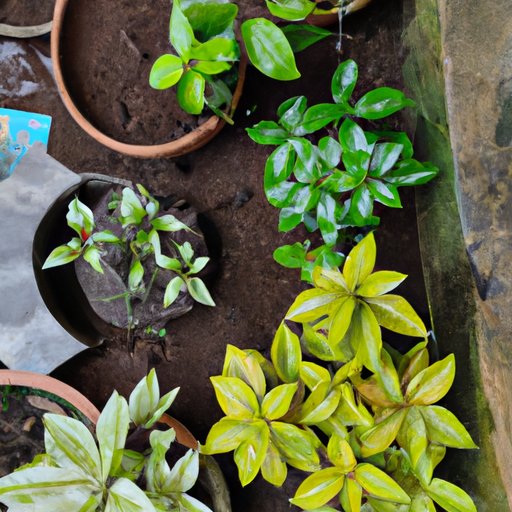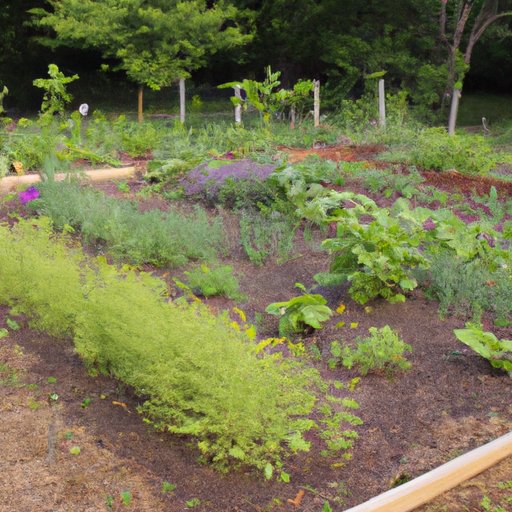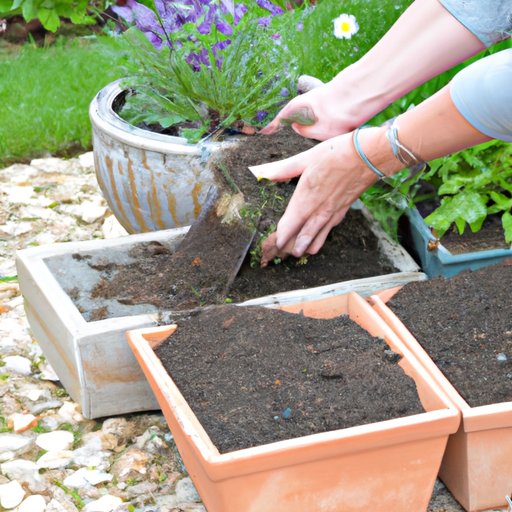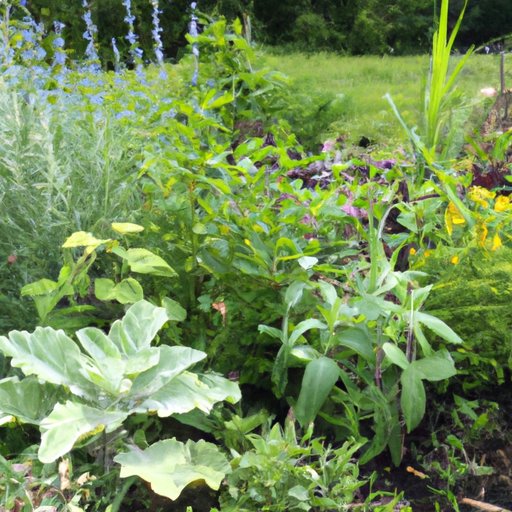Introduction
If you’ve ever wanted to create a lush, vibrant, and low-maintenance garden, then companion planting may be the answer you’re looking for. Companion planting is an age-old agricultural practice of planting two or more species of plants close together for mutual benefit. When done correctly, companion planting can be an effective way to increase yields, reduce pests, and even improve soil health.
The key to successful companion planting lies in understanding which plants work best together and how to combine them effectively. In this article, we’ll explore the benefits of companion planting and provide tips for selecting plants that thrive together. Plus, we’ll show you how to maximize space in your garden with the right plant combinations.
What is Companion Planting?
Companion planting is the practice of growing two or more types of plants together in order to benefit each other. It is believed that certain combinations of plants can help deter pests, attract beneficial insects, and improve soil quality. The idea behind companion planting is that certain plants can help protect each other from disease and pests, while others can provide shade, shelter, and nutrients.
For example, planting basil near tomatoes can help keep away harmful pests such as aphids and whiteflies. Similarly, planting marigolds near cabbage can repel cabbage moths. In addition to pest control, some plants can also help improve soil fertility by providing nitrogen or other essential nutrients.

Plant Combinations for Beginner Gardeners
When it comes to companion planting, there are many combinations to choose from. But for beginner gardeners, it’s best to start with a few easy-to-care-for plants that will do well together. Here are a few ideas to get you started:
Choosing the Right Plants
When choosing plants for companion planting, look for plants that have similar growing requirements. For example, if you’re planting tomatoes, consider planting them with herbs like basil or oregano. These herbs require the same amount of sunlight and water as tomatoes, so they make great companions.
Researching Your Soil
Before you begin planting, it’s important to research your soil. Knowing the pH level, nutrient levels, and drainage capabilities of your soil will help you select plants that will thrive in your garden. Additionally, researching your climate and the plants that do well in your region can help you choose the right plants for your garden.
Spacing Considerations
Once you’ve chosen your plants, it’s important to consider spacing. The size and growth habits of each plant should be taken into account when determining how far apart to plant them. Generally, larger plants should be planted further apart than smaller ones, and those with aggressive root systems should be kept farther away from delicate plants.
Creating Colorful and Lush Garden Beds
One of the most rewarding aspects of gardening is creating colorful and lush garden beds. There are many ways to achieve this, but one of the easiest is through companion planting. By combining different plant varieties, you can add texture, color, and interest to your garden bed.
Adding Texture to Your Garden
Texture is one of the most important elements of a garden. Different leaf shapes, colors, and sizes can create an eye-catching display. Try pairing large, bold leaves with small, delicate ones. Or, mix different shades of green with foliage in varying shades of purple, red, and yellow.
Utilizing Color Combinations in Your Garden Beds
Color is another important element of a garden. Combining different hues can create a stunning visual effect. Try mixing cool blues and purples with warm oranges and yellows. Or, pair bright pinks and reds with subtle greens. You can also add interest by using plants with variegated foliage.
Using Perennials, Annuals, and Shrubs in Combination
Perennials, annuals, and shrubs all have different growth habits and blooming times. By combining these three types of plants, you can create a garden that blooms throughout the season. For example, plant a tall shrub in the back of the bed, then fill in the front with colorful annuals and perennials. This will create depth and dimension in your garden bed.

Maximizing Space in Your Garden with Companion Planting
In addition to adding beauty and color to your garden, companion planting can also help you maximize space. By carefully selecting plants and arranging them in specific patterns, you can create a lush, full garden without taking up too much space.
Growing Vertically
Vertical gardening is a great way to save space in the garden. A trellis or other support structure can be used to grow vines and sprawling plants upwards instead of outwards. This will allow you to fit more plants in a small area, while still creating a beautiful display.
Planting in Layers
Layering plants can also help you make the most of a small space. Start by planting taller plants in the back, then add shorter plants in the middle, and finish with ground covers in the front. This will create a layered look that adds depth and interest to your garden.
Companion Planting to Create a Lush Garden
By combining plants that have similar growth habits and requirements, you can create a lush garden with minimal effort. Planting tall and short plants together can create a fuller look, while combining plants with different textures will add interest to your garden bed.
Tips for Selecting Plants that Thrive Together
When selecting plants for companion planting, it’s important to consider the needs of each individual plant. Here are a few tips to help you choose the right plants for your garden.
Identifying Plants that Need Similar Conditions
Start by researching each plant’s growing requirements. Look for plants that need similar amounts of sun and water. Additionally, consider the soil type and pH level that each plant prefers.
Determining How Much Sun or Shade Each Plant Needs
Different plants need different amounts of sunlight. Some plants prefer full sun, while others do better in partial shade. Knowing how much sun or shade each plant needs will help you choose plants that will thrive in your garden.
Understanding the Water Requirements of Each Plant
It’s also important to consider the water needs of each plant. Some plants require more water than others, so it’s important to know how much water each plant needs in order to ensure that all plants are properly hydrated.

Making the Most of Your Garden Soil with Plant Pairs
In addition to providing protection from pests and increasing yields, companion planting can also improve soil health. By planting certain pairs of plants together, you can enhance nutrient availability and create a healthy soil ecosystem.
Improving Soil Quality Through Companion Planting
Certain plants, such as legumes, can fix nitrogen in the soil, which helps to improve soil fertility. Other plants, such as deep-rooted vegetables, can help break up compacted soil and improve drainage. By planting these types of plants together, you can create a healthier soil environment.
Enhancing Nutrient Availability
Some plants can also help enhance the availability of nutrients in the soil. For example, planting onions next to carrots can help increase the availability of nutrients such as potassium and calcium. Additionally, planting clover next to other plants can help increase nitrogen levels in the soil.
Building a Healthy Soil Ecosystem
Finally, companion planting can help build a healthy soil ecosystem. Certain plant combinations can attract beneficial insects such as ladybugs and lacewings, which can help keep pests under control. Additionally, planting flowers can attract pollinators, which can help increase yields.
Growing a Low-Maintenance Garden with the Right Plant Combinations
By combining the right plants, you can create a low-maintenance garden that requires minimal effort. Here are a few tips to help you create a low-maintenance garden with companion planting.
Reducing Weeds
Weeds can quickly take over a garden, so it’s important to keep them under control. Planting dense ground covers can help reduce weeds, as can planting taller plants in the back of the bed. Additionally, mulching can help prevent weed seeds from germinating.
Attracting Beneficial Insects
Beneficial insects can help keep pests under control and increase yields. To attract beneficial insects, plant flowers that provide nectar and pollen. Additionally, planting certain herbs such as dill and fennel can help attract beneficial insects to your garden.
Utilizing Natural Pest Control
Certain plants can also help naturally control pests. For example, planting marigolds near vegetables can help repel harmful insects. Additionally, planting garlic near roses can help ward off Japanese beetles.
Conclusion
By combining the right plants, you can create a beautiful and low-maintenance garden. Companion planting can help repel pests, attract beneficial insects, and improve soil health. Additionally, it can help you maximize space in your garden and create a lush, colorful display. With a little research and planning, you can create a garden that will thrive for years to come.
(Note: Is this article not meeting your expectations? Do you have knowledge or insights to share? Unlock new opportunities and expand your reach by joining our authors team. Click Registration to join us and share your expertise with our readers.)
